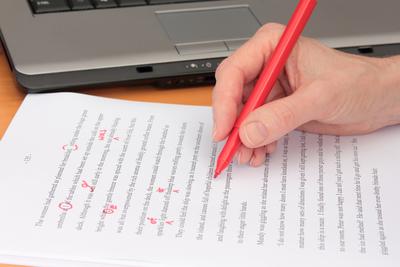
Proofreading is usually the final step before submitting your manuscript to a journal or a publisher. Performing a thorough proofread of your work will allow you to fix any errors that you may have missed and clarify your intended meaning in some situations. Even though your personal computer may often have automatic word processors that check spelling and grammar, these technologies are often unable to catch tricky errors and words that are commonly misused, such as homophones. This is why the best way to proofread a paper is to do a word-by-word review. Things like grammar mistakes and misplaced punctuation can change the whole meaning of your sentence, and when it comes to research, it is important for an academician to make sure their meaning is portrayed accurately.

Using Proofreading in the Editing Process
Editing may present a huge task to many, but it is a fundamental part of the publishing process. Since it involves many different parts, it is helpful to break down into separate pieces. The first part involves organization. When it comes to organization, it is important to ensure that you have a clear introduction and conclusion, and the sentence format you are using portrays the meaning you intended. Since these are the sections of a paper read most often, they are often a big part of the proofreading process. Then, you will need to look at the paragraph structure, focusing on having clear transitions between the paragraphs and having a topic sentence introducing the main idea of every paragraph, when relevant. Another part of the editing process deals with the main idea of the manuscript. This involves having a clear and focused thesis statement and wording it in a way that presents the main goal of the manuscript. The main ideas of the manuscript also need to be supported by clear evidence. Then, you would need to look at clarity when editing your paper. This includes providing definitions and evidence whenever it is necessary. Editing for clarity would also involve you looking for the repetition of words, the structure of your sentences, and usage of the correct technical terms (Enago Academy, 2022).
Proofreading after the editing process will help you catch any errors and make revisions when necessary. Like the process of editing, the proofreading process also requires a systematic approach. The first thing to keep in mind is to take your time. Simply put, if you think you have found all the mistakes after the first read, you are likely wrong. Many people struggle with slowing down to proofread, so reading the manuscript out loud is a useful tool to help you slow down and spot any errors. Try to proofread the manuscript in different parts by dividing the manuscript into sections. This will help you focus on and tackle one specific section at a time, so you do not feel overwhelmed by the process of proofreading the entire manuscript in one read. A helpful tip would be to highlight common errors, as this will help with both the manuscript you are currently working on and any future writing assignments. This is because the more familiar and aware you become of your common mistakes, the more likely you are to avoid them in the future.

Helpful Tips for Proofreading
There are a few tips that experts find useful to their proofreading process. For one, distancing yourself from your work will help you see your manuscript in a new light and might help you find errors that you could have otherwise missed. Try to align this with a specific time every day, as experts have found that proofreading at the same time, whenever you are most alert, helps you spot more errors. Printing a hard copy of the text is also sometimes useful, as it will give you a different visual format which is likely to allow you to see the words anew. An uncommon tip is to read the paper backwards, which would make you read the sentences as is without being too focused on the context. This should help you catch any spelling or grammatical errors (Walden University, n.d.).
eContent Pro offers copy editing and proofreading services that allow you to ensure that your manuscript will be clear of errors when you finally submit your paper. With high-quality, fast, and affordable services, our copyediting and proofreading team will make the demanding process of submitting a manuscript less stressful for you. Our team’s expertise ranges from basic grammar, spelling, punctuation, and terminology to adherence to citation styles and making the writing appear more cohesive. Visit our services page to learn more.

REFERENCES
- Walden University. (n.d.).Writing a paper: Proofreading. Academic Guides. https://academicguides.waldenu.edu/writingcenter/writingprocess/proofreading